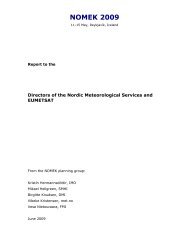International Symposium on Mitigative Measures against Snow ...
International Symposium on Mitigative Measures against Snow ...
International Symposium on Mitigative Measures against Snow ...
You also want an ePaper? Increase the reach of your titles
YUMPU automatically turns print PDFs into web optimized ePapers that Google loves.
<str<strong>on</strong>g>Internati<strong>on</strong>al</str<strong>on</strong>g> <str<strong>on</strong>g>Symposium</str<strong>on</strong>g> <strong>on</strong> <strong>Mitigative</strong> <strong>Measures</strong> <strong>against</strong> <strong>Snow</strong> Avalanches<br />
Egilsstaðir, Iceland, March 11–14, 2008<br />
On a new set of rules for avalanche catching dam design<br />
in Switzerland<br />
Martin Kern*, Marc-André Baillifard, Stefan Margreth and Joseba A. Calvo Soto<br />
WSL Institute for <strong>Snow</strong> and Avalanche Research SLF, Flüelastr. 11, CH-7260 Davos, SWITZERLAND<br />
*Corresp<strong>on</strong>ding author, e-mail: kern (at) slf.ch<br />
ABSTRACT<br />
A new dam design procedure has been developed in Switzerland which takes into account<br />
different energy dissipati<strong>on</strong> mechanisms during the avalanche−dam impact. The new design<br />
procedure represents a more objective approach to dam design as it does not require a<br />
subjective estimate of the energy dissipati<strong>on</strong> implied in the traditi<strong>on</strong>al „Salm rule of thumb“.<br />
From scaled laboratory experiments, we empirically found hat the energy dissipati<strong>on</strong> may be<br />
governed by gravitati<strong>on</strong>al or momentum driven effects, depending <strong>on</strong> whether a so-called<br />
granular bore develops or not. The degree to which a granular bore develops decisively determines<br />
the dam height necessary to stop a given avalanche. The necessary dam height then<br />
depends <strong>on</strong> the avalanche Froude number and <strong>on</strong> the dam geometry given by the mountainside<br />
dam inclinati<strong>on</strong> and <strong>on</strong> the length and inclinati<strong>on</strong> of the dam apr<strong>on</strong>. We dem<strong>on</strong>strate how<br />
the theoretical descripti<strong>on</strong> of the avalanche−dam interacti<strong>on</strong> was derived and then empirically<br />
justified in scaled experiments with chute flows of dry cohesi<strong>on</strong>less material and snow. We<br />
present some evidence for the applicability of the theoretical framework <strong>on</strong> the real-scale<br />
from observati<strong>on</strong>s at the full-scale field site in Vallée de la Si<strong>on</strong>ne. Furthermore, we discuss<br />
the validity of the theory in the light of similarity c<strong>on</strong>siderati<strong>on</strong>s. The theoretical descripti<strong>on</strong><br />
has been c<strong>on</strong>densed into a set of rules for practiti<strong>on</strong>ers in charge of dam design. We test this<br />
set of rules in a series of case studies reviewing project documentati<strong>on</strong>s of several avalanche<br />
catching dams that currently are in the project phase in Switzerland.<br />
Kern, Baillifard, Margreth and Calvo Soto 39











